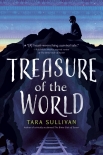Treasure of the World by Tara Sullivan (free ebook reader txt) 📕

Read free book «Treasure of the World by Tara Sullivan (free ebook reader txt) 📕» - read online or download for free at americanlibrarybooks.com
- Author: Tara Sullivan
Read book online «Treasure of the World by Tara Sullivan (free ebook reader txt) 📕». Author - Tara Sullivan
Potosí, the southwesternmost departamento (similar to a U.S. state) of Bolivia, is home to a mountain that has been mined without a break—or much of a plan—for almost five hundred years. That mountain is the Cerro Rico, and at the foot of it is the city of Potosí. Despite all the agreement that children should not work in mining, estimates are that 3,000–13,000 children between the ages of six and sixteen work in the mines of the Cerro Rico.
Mining is dangerous work: even if one survives the heavy metals, the toxic gases, the unpredictable explosions, and the occasional collapse of the tunnels snaking through the mountain, breathing the rock-dust-laced air without protective equipment inevitably leads to lung disease. Far from being the “Beautiful” or the “Rich” hill that it is sometimes called, to the over eight million people who have perished in it over the centuries, Potosí has another name: the Mountain That Eats Men.
Precious metals have always outweighed the value of human lives on the mountain of Potosí. From the tyrannical mita system the Spaniards implemented to exploit indigenous labor, where Incan men were forced to work for months without seeing the light of day, to the thirty thousand enslaved Africans who ground away their lives turning the mighty wheels of the colonial mint, the price of Potosí’s silver has always been blood.
There is little silver left in the Cerro Rico anymore, but mining has continued unabated to the present day, with poorer metals such as tin and zinc replacing silver as the mountain’s main output. Today, men still flock to the mountain for work whenever there is a bump in mineral and metal prices—just as they travel to the nearby salt flats of Uyuni to harvest the rare metal lithium to be used in our smartphones and the batteries for our electronics.
When you think about it, placing a value on a metal is a strange thing. You can’t eat it, nor does it help you in any concrete way. To use money means that everyone in a society agrees that something with no inherent value (a rock, a bit of metal, a piece of paper) is worth something. Usually, that value relates roughly to scarcity: the less of something there is, the more we think it should be worth. Before the discovery of the mines in Potosí, silver was quite rare and was worth three times as much as gold. When the Cerro Rico flooded world markets with silver, silver dropped to being one-sixth the value of gold.
Not every culture in the history of the world has used money. The Inca, the indigenous group that ruled the largest South American empire before the arrival of the Spanish, did not use money. The Spaniards did. In fact, one of the most important reasons the Spaniards sent men to the “New World” was to find more sources of precious metals. The rallying cry of the European explorers is frequently summed up as “God, glory, and gold.” Wave after wave of explorers came in search of El Dorado, a mythical Native American city said to be made entirely of gold.
Though they never found El Dorado, the Spanish did discover so much silver in the one hill of the Cerro Rico that it bankrolled (and then, due to the Spanish crown’s international debt, bankrupted) Spain as a global superpower, and inflated currencies as far afield as the Ottoman Empire and the Ming Dynasty.
Potosí was hugely famous in the sixteenth and seventeenth centuries. In the 1600s, it was the fourth largest city in the Christian world. It was a hub of wealth and power: it was larger than London, Paris, and Madrid. Rumors circulated that the city streets were paved with silver. The first epigraph on this author’s note, from the city’s first coat of arms in 1547, captures this sense of grandeur. It was “the king of all mountains and the envy of all kings.” Today, it is the poorest city in one of the poorest countries in the western hemisphere. Most have never heard of it.
The second epigraph is from a mother I met working as a palliri on a slag heap of the Cerro Rico when I took my research trip for this book in 2016. Doña Serafina Sandoval Condor was sending her youngest child, a seven-year-old, to school in the back of a pickup truck along with her daughter’s child, also seven. That daughter worked the slag heap beside Doña Sandoval. Her greatest wish in life was that her kids not suffer as she had.
That research trip was the first time I had been back to Bolivia in over twenty years. I lived in Bolivia from the age of five, when my family moved there from Ecuador, until the age of ten, when we left to move to the Dominican Republic. We likely would have stayed longer, but my eyes were damaged as a result of ultraviolet radiation leaking through a hole in the ozone layer of the atmosphere, and the doctor finally gave my family the ultimatum: move before the next dry season or she’ll go blind.
Though my eyes healed in the decades since I left my childhood home, I was unsure if it was safe to return to those altitudes for my research trip. The doctors couldn’t guarantee anything, but I wanted desperately to go. So, with the tenuous approval of an ophthalmologist and a large bag of various eye drops, I headed





Comments (0)